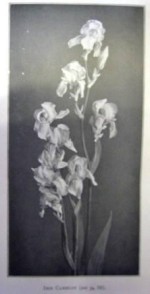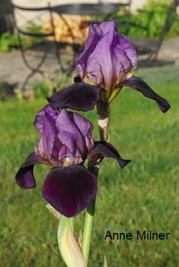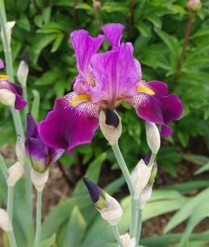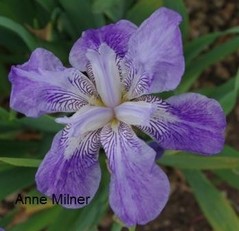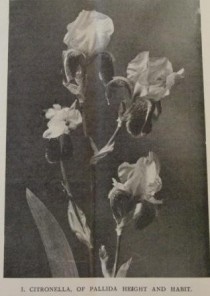CAMELOT (1918)
TB-M-W2 (AIS checklist 1939: superseded?)
Assuerus x Mrs Horace Darwin
Habit and foliage like Ma Mie but foliage 24" [60cm] high. Flower stem 32"[80cm], 8 flowered. Flowers small, close well proportioned, stiff. Standards waved 1¾"x 1⅞", margins waved veined and suffused lavender. Falls sigmoid and tucking back, 1¾" x 1⅜" margins feathered lavender. Crest lavender, beard tipped orange. (paler + redder than Ma Mie)( RHS trials, Wisley: 1925-27)
The large branching of Camelot bears flowers having a creamy white ground, faintly suffused with blue at edges of falls and more blue in standards. The flower is rather unique as it fades with age to almost cream white. (Gardeners Chronicle: 1919)
CANOPUS (1921)
TB-MLa-S3M (AIS checklist 1939: superseded?)
Trosupurba x Dominion
Standards puce to reddish violet. Falls pansy-violet with bold reticulations of purple brown. Very free flowering. (AJB)
Bicolour.R-V (d). Brief: Large. Standards arched, light ampora purple. Falls straight hanging, velvety purple. Stalk low and well branched, growth vigorous 33"[85cm]. Details: Styles pale straw at edge, beard yellow orange, haft whitish, broadly reticulated brown, substance exceptional.Remarks: “Rather the colouring of Alcazar but richer.” AJB. (AIS Bulletin 1922.)
CAPORAL (1919)
TB-M-R9M
Self, type Rose Unique. Chinese violet to magenta with conspicuous pale amber haft. Standards arched, falls straight hanging; beard whitish, brown speckled. (AJB: 1920)
This grand variety is a bright reddish-violet self, and when massed has a redder effect than any other variety except Roasalba. It is exceedingly free flowering, and is a strong grower with branching stems and the individual flowers are large and well formed. 3'[90cm]. (Orpington:1920)
CARADON (1932)
TB-Mla-S6D
Grace Sturtevant x ?
V226.53: A sister seedling to Grace Sturtevant, and the nearest to a Dominion variagata yet raised. The standards are honey yellow and chamois. The falls are purple-black. A most arresting and uncommon iris, which I think very highly of. (Olive Murrell: Seen at Mr AJ Bliss’ at Morwellham. 1929)
See also in COLLECTION
CARDINAL (1919)
Trosupurba x Dominion
Mla-S9D (AIS Checklist 1939)
RHS AM 1927 RHS FCC 1930
The finest in form and richest coloured of the Dominion race. Standards lavender shading to lilac. Falls rich prune purple with a crimson glow in the sun. Tall fine habit and free flowering. Cardinal I call intermediate, not red-toned. (AJB in AIS Bull.#43)
Of moderate vigour, with nearly green 18"[45cm] foliage. Flowering stems 24" [60cm] 5 or 6 flowered. Flowers closely set, of medium size, faintly scented. Standards domed, 2⅜ X 2⅛ " bronzy light amparo-purple with darker edges; Falls hanging straight 1⅞ X 2" wide, very velvety raisin purple. White beard tipped orange. (RHS Trials Wisley1928)
See also in COLLECTION
CARFAX (1930)
TB-M-R1M
CM, BIS silver gilt medal 1929
Silver Gilt Medal to Mr AJ Bliss for Carfax. A tall widely branching, very free flowering iris with very large flowers of fine Dominion race form and rich red-purple colour. Height 3’6” [107cm]. Branching from low down, widely and four way. From six to eight branches on a full sized spike with a corresponding number of flowers out together. A very large flower of fine form (Dominion being one if its grandparents). Standards smooth and arching 2¾” x 2 3/8” broad. Falls broad hafted, smooth, hanging,2¼”x 2 5/8” (blade only). Colour: standards Rosolane purple (67 Ridgeway) to auricular purple (67k) at margins. Falls rich velvety Dahlia purple to Dark red purple(67k to m). Close defined red-brown reticulations not specially conspicuous. Very good substance and slight but distinct scent. (List of Awards1929: BIS yearbook).
A magnificent sight here, over 50 plants being in full bloom. In colouring it is near to Archeveque,and stands over 40" [102cm]high, but so much praise has already been bestowed on this fine iris in the Gardening Press that I will not go into any further descriptions or details here. It is really unique (Olive Murrell BIS yearbook 1930, at Morwellham)
See also in COLLECTION
CARTHAGENA
TB (obsolete AIS Checklist 1939; superceded?)
CECELIA
TB. No information
CELENDINE
TB (obsolete AIS Checklist 1939. Not yet in Commerce)
CENTURION (1920)
TB-B3D
(obsolete? AIS checklist 1939) (superseded Wills 1950)
Dominion x E H Jenkins
RHS AM 1929
Dark intermediate type. large flowers. Semi spreading falls smooth and flat with slightly flaring tips; rich velvety blackish purple. Standards clear lobelia violet, reddish toned at base. Finely branched spikes and free flowering.2'9" [85cm] (AJB 1920/21)
Habit of Abdera. Foliage 24"[60cm]. Flowering stem 36"[90cm] straight 7-8 flowered, flowers large, well proportioned stiff, scent faint. Standards domed 2¾"x1¼", pale bluish violet with smoky brown veins at base. Falls drooping 2x 2¼" rich velvety nigrosin-violet. Beard orange in upper half. Near Dominionbut paler. (RHS Trials Wisley)
CLEMATIS (1917)
Cordelia x Princess Beatrice
TB-M-B3M (Superseded AIS Checklist 1939.)
SNHF CM 1922
CLEMATIS caused much discussion because of its peculiar flat form and Mr. Bliss had to come to its
defence as he was criticized for allowing it to be introduced. The color was a very clean, clear blue, much more a real blue than was the case in iris as known then and it made a good mass in the
garden and so it had its defenders but the sticklers for a particular form in irises were irate and said it was a cripple in exactly the same manner as discussion raged over BRANDYWINE, some
upholding it for its blueness, others damning it because of its bad habit of having extra parts and trying to "go double." I do not mean that CLEMATIS had a doubling habit but the standards lying
flat as they do gave an appearance not unlike the kaempferi hybrids we know as "Japanese" iris. (EAS Peckham in AIS Bull 43; 1932)
Very unique and well named in being like a large 6 petalled clematis or fine japanese iris. Clear
light violet with variable veining at base. Vigorous, floriferous fragrant. 24"[60cm] '...but sticklers for a particular form…were irate, and said it was a cripple' (EAS Peckham in AIS Bulletin
1932)
See also in COLLECTION
CITRONELLA (1922)
Mla-Y9D (AIS Checklist 1939
(Mme Chereau x Jacquesiana) x (Queen of May x Cordelia)
RHS AM 1922 silver cup 1922
A large bright yellow flower standing high above the rest. Its standards are of a clear citron at first, which bleaches to a pale primrose with age, and the falls are a crimson purple overlaying a yellow ground which shows at the margin…..though it is not as outstanding a flower as Bruno. (AJB in AIS Bull. 43. 1932)
Tallest yellow flowered iris yet raised, with bold and arching standards of fine shape and of luminous quality. Bright clear yellow, citron in tone, deepening at base to gamboge. Style arms clear pure yellow. The brightest of orange beards extends more than 1/3 length of fall and a medial yellow line continues from the beard to the tip. Falls of fair size, rich ruddy brown, paling at edges. Citronella has been more discussed than any other iris this spring, some judges taking exception to the fall, others equally authoritative considering it exceptionally rich and fine. However, we have in Citronella the finest yellow flowered iris in cultivation. 2'9”[85cm] (Wallace 1922)
COLONNA (1920)
TB-M-B3L
Dominion x
Large flowers of very fine form. Standards broad and arching, clear lavender violet. Falls circular, very smooth and flat, hanging, 2¼", cotinga purple with bold reticulations at haft. Fresh blue toned flower. Unbranched spike. 2' 9" [85cm](AJB: 1920/21)
COMMODORE ( 1921)
TB-M-B1M (Superseded? AIS checklist 1939 name reused 1955)
Finest pallida form, violet-blue. Standards are smooth circular and finely arching, falls broad and smooth. The colour is a uniform pure violet blue. Strong and rapid grower, but keeping compact, of medium height and extremely free flowering. This is an excellent garden variety (Orpington: 1921/23)
CONCHOBAR (1921)
TB-M-R7D
Trosupurba x Dominion
Improved Alcazar. Flowers about the same size or larger, and of much finer form and better substance. Colouring is similar but with less yellow on hafts and style arms, much clearer and brighter. The falls having the rich velvety surface characteristic of the Dominion race. It has the same branching habit. 3' 6" [107cm] (AJB: 1920/21)
CRESSET (1932)
TB-M-R7D
Magnifica x Bruno
Not at all what I expected,……. very striking. Flowers are really large, but falls tend to fold at sides. This is a general result in my Magnifica seedlings (AJB in AIS Bull. 43. 1932)
CRESSIDA (1932)
TB-M-S6D
Swazi x ?
Stock No: V224.8 Of Swazi parentage; colouring nearer to Bruno or Cardinal (AJB in AIS Bull. 43. 1932)
V. 224.8. A large handsome iris of very dull and sombre colouring. Standards smoky purple. Falls velvety purple, flaring. Blooms of great size and texture. 2'6" [75cm] high, (Olive Murrell: Seen at Mr AJ Bliss’ at Morwellham. 1929)
CRETONNE (1919) PBF
TB-M-S9D
Assuerus x Maori King
Size fair, form short, open, rounded, flowering habit free, 24"[60cm]. Good substance, frail - firm texture, smooth surface, good fragrance. Standards chinese violet - matthews purple, edged with vinaceaos russet - old gold, tinged old gold at base, reticulated red brown, cupped, open, conic, tips adpressed, blade obovate, notched, waved 1¾x 2⅛". Falls velvety intense blackish purple, reticulated with same - more reddish brown, broadly tinged with old gold on lavender outer haft, bronzed at base. Flaring, slightly drooping, wedge shaped, convex, obovate 1⅛ x 1¾". Beard firm, very dense, projecting, conspicuous, orange; haft narrow, channeled, reticulations fine-broad, close. Style branches broad, overarching, brilliant old gold, keeled with red purple. Crest large fringed, purple brown. Pollen plentiful. Spathe valves green, scarious, tinged red. Growth moderate - vigorous, stiff. Leaves slender, deep glaucous green, tinged at base. 2-3 blooms at once, floriferous, Stalk short high branching, fastigate, 2 laterals, erect with 9 buds. (Cornell University: #100)
CYDONIA (1920)
TB-M-Y9M (obsolete AIS checklist 1939 superseded?)
Large flowers, distinct form. Finely arching standards and very broad hafted spreading falls. Clear lemon-amber yellow with bright red brown reticulations on haft and blade, out to end of beard which projects to middle of segments. Branching spikes 2' 9"[85cm] (AJB: 1920/21)

